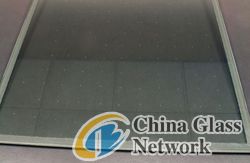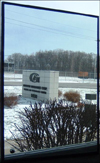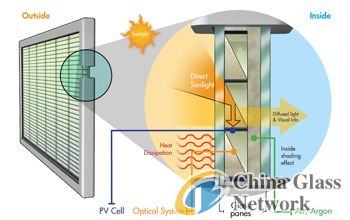Post Time:Jun 17,2013Classify:Industry NewsView:501
Glass or window and door pundits who have hoped for a Moore’s Law like effect to hit our industry and consistently drive technological advances in a timely manner may finally be in luck.
Oh, we may not realize the speed or intensity of change that occurs in the semiconductor or electronics industries. But we certainly are entering an era in which we can expect to see great leaps forward in technology—increased glass functionality and performance in short periods of time even as we enjoy the decreased costs of such superior performance. Only time will tell whether or not we identify an industry champion whose name will be attached to something as enduring as a “law.”


A prototype vacuum insulating glass unit or VIG, and a look at the type of view it offers to the outside.
Sure, windows and doors remain a major source of heat transfer in a home, regardless of climate or season. It’s a challenge we continue to address. Today’s windows are designed to provide comfort, save energy and look great. In fact, the most technologically advanced window will not only control the sun, blocking heat from entering a home or insulating a home in cooler climates, they enhance our lives by keeping rooms brighter and the views crisper. The windows of the near future will be designed with regionally specific benefits in mind so that homeowners can maximize energy savings and comfort while optimizing daylight and glare. So let’s take a look at some of the emerging residential glass technologies that will get us where we want to be.
CURRENT TECHNOLOGIES
Spectrally-selective low-emissivity glass, to cite the obvious example that’s been around a while, acts as a solar energy filter; some portions of the solar spectrum pass through, while other portions are rejected. In this way it is possible to minimize unwanted solar heat in cooling dominated climates or maximize beneficial solar gain in heating dominated climates without unreasonably sacrificing visible light transmission or thermal insulation in any climate. There are more spectrally selective low-E options available today than at any time in history. Although this proliferation of low-E products has complicated the decision-making process, the potential to maximize comfort and energy efficiency in any climate has never been greater.
In spite of recent advances in technology that provide better thermal and solar performance, it will be difficult to use a single low-E coating in conventional window configurations to achieve Energy Star qualification in both Northern or Southern climate zones of the United States without sacrificing something–mainly light transmission or glare reduction. In the South, International Energy Conservation Code compliance and Energy Star qualification are tied to increasingly lower solar heat gain coefficient values, while compliance and qualification in the Northern climate zones will favor the use of higher SHGC coatings in triple glaze configurations or configurations that incorporate interior surface low-E coatings.
Today’s advanced “triple-silver” low-E coatings are designed to achieve more light transmission with lower solar heat gain and can span the regional requirements best, but often still result in too much light (glare) in waterfront or desert environments and too little light and no passive heat for applications in the Northern climate zone and especially Canada.
What will emerge in the next three to five years are new and affordable technological advances that will allow leading windows to become smarter and more energy efficient, by adapting to changing environmental conditions–dynamic glazing, or by providing significantly better thermal barriers–such as vacuum insulation. These technologies are already available in various forms of commercialization today, with improvements and new versions in various stages of development or validation.
With the anticipated release of the 2014 Energy Star criteria, scientists and engineers are working to make today’s products better to meet the changing standards. This includes:
•Low-E coatings for every climate, elevation and orientation, including triple-silver, triple-glazing static coatings and fourth surface coatings;
•Specialty coatings to boost U-value, increase fade protection, reduce condensation and significantly improve scratch resistance;
•Technological enhancements, such as advanced spacer systems, vacuum insulated glass (VIG), dynamic glass and glazing systems with integrated photovoltaic functionality
•As manufacturers switch from conventional to higher performance glazing to save energy, the spacer systems need to be improved as well. For conventional window insulating glass units, the glass layers are held together by a spacer and sealant system. The use of warm-edge spacers—low thermal conductance spacers that reduce heat transfer at the perimeter of an IGU–will increase particularly in cold climates.
VACUUM GLASS
From an insulation perspective, the silver bullet is vacuum glazing, a technology that has been around for several years but up to now, not cost effective and generally lacking adequate performance and therefore a rarity in North America. Some inroads have been made in Europe and Asia but commercial viability currently remains elusive in all regions of the world.
The goal of vacuum glass is to offer insulating performance equal to or better than that of triple-glazing, but with only two layers of glass The two layers of glass will mean better light transmission and a very thin profile that resembles a single (monolithic) pane of glass, which architects love and window companies can benefit from by reducing the size of their window frames and profiles. Most importantly, the cost, energy saving and noise reduction benefits of windows with vacuum glazing will mean that more windows can be used in homes and other structures, disrupting the current trend of decreased window to wall ratios. Recent developments indicate the potential for the true commercialization of windows with vacuum glass in North America by 2014 with thermal performance exceeding R8.
Particularly well suited to heating-dominated applications, VIG is expected to be launched first in residential products targeted at Northern climate zones. VIG manufacturing technology is expected to be geared toward custom sizes. In fact, a significant portion of the market for VIG is expected to be in replacement and remodel oriented products–a segment that almost exclusively needs made-to-order sizes. We expect residential window makers will be able to use VIG in existing windows to achieve better than current performance with what we believe will be minor modifications. Optimal performance and the best aesthetics, however, will come from windows specifically designed around VIG.
DYNAMIC GLAZING
Windows with dynamic glazing allow building occupants to manually or automatically control a window to change from clear to dark to meet the optimal solar control requirements of the day or season. Photochromic, thermochromic and electrochromic glazings are advanced technologies, using either chemical or low voltage currents to modulate near infrared and visible light transmittance. These changes allow the glass to block solar heat in the tinted state to reduce cooling requirements, and transmit light in the clear state to reduce lighting and heating costs. Although these technologies have been available for some time, the combination of performance, aesthetics and pricing have limited their architectural use. Recent advances suggest the potential to improve the overall value proposition and availability of dynamic window technology before 2014.
The electrochromic glazing that is available today requires wiring and electrical infrastructure. That suggests these products might succeed in the new construction market first, because of the easerir install. Sunrooms and Florida rooms with large panels would seem to be particularly good candidates for this type of dynamic glazing. Other technologies–including photochromic and thermochromic glasses–use chemical processes to change shading. They typically do not require the electrical infrastructure and could be more easily integrated into remodeling and replacement fenestration products.

A rendering showing what a photovoltaic insulating glass unit would look like and how it would function.
BIPVs
Another emerging technology is the use of building integrated photovoltaics that can capture the light from the sun and turn it into energy. The ideal photovoltaic window would be designed around a standard insulating glass unit. Within the air cavity sits a system of optics and PV cells. Already in place for commercial applications, manufacturers can incorporate the same technology to capture the sun’s rays to be transferred and used to supplement or potentially replace electricity delivered to a home via the traditional power grid.
As with electrochromic glasses, electrical infrastructure requirements will make BIPV products more of a challenge to install in the remodeling and replacement market. In general, commercial applications will lead the way when it comes to first large scale applications of BIPV and dynamic glazing. The value of these technologies is immediately higher in the commercial market due to the relative glass area compared to the residential segment. Commercial and architectural applications, however, will provide valuable lessons that will enable suppliers to help scale solutions for residential applications.
Looking into the window of the future you will begin to see a hybrid of coatings and other technology—used in both the North and South—that will include vacuum, dynamic and photovoltaic glass. The same technology we use in our smart phones or tablets will also be found in IGs for touch screen functionality to control a room’s temperature, turn on the lights, check our email or watch the news.
As an industry, we also will see greater collaboration between glass manufacturers, window makers, window dealers, architects, homeowners, builders and remodelers to find the right glass for the right climate, matched with the most cost efficient aesthetically pleasing hardware. Collaboration will also continue between the private and public sector, as industry continues to advise the code makers on what is feasible and what the proposed codes will cost.
People today are demanding a well insulated home at a price they can afford without sacrificing beauty or charm. In 5 years, 10 years or 20 years, that will not change. As the United States looks for ways to reduce our dependence on foreign oil, we will focus on making our building and homes more energy efficient. In the years ahead, consumers will have choices. Choices that save and even create energy, are cost effective, provide protection from the environment and add to the design and charm of a home.
Source: http://www.windowanddoor.com/article/may-2012/new-Author: shangyi
PrevPaul Glass: NZ equities costly but not in bubble
Techtextil 2013: Owens Corning Launches Glass-Based Solution for Construction and TransportationNext